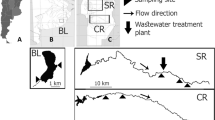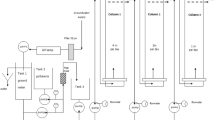Abstract
Purpose
Polar chemical integrative samplers (POCIS) were examined for their sampling efficiency of 12 pesticides and one metabolite commonly detected in surface waters. Laboratory-based calibration experiments of POCISs were conducted. The determined passive sampling rates were applied for the monitoring of pesticides levels in Lake Amvrakia, Western Greece. Spot sampling was also performed for comparison purposes.
Methods
Calibration experiments were performed on the basis of static renewal exposure of POCIS under stirred conditions for different time periods of up to 28 days. The analytical procedures were based on the coupling of POCIS and solid phase extraction by Oasis HLB cartridges with gas chromatography–mass spectrometry.
Results
The recovery of the target pesticides from the POCIS was generally >79% with relative standard deviation (RSD) <16%. The calibration results revealed an integrative uptake of all pesticides for 28 days and the calculated sampling rates ranged from 0.025 to 0.388 L day−1 with RSD <29%. Low nanogram/liter levels of pesticides such as diazinon, alachlor, and s-metolachlor were detected during the monitoring campaign using both passive and spot sampling whereas higher concentrations were measured by spot sampling in most cases.
Conclusions
Passive sampling by POCIS provides a useful tool for the monitoring of pesticides in aquatic systems since integrative sampling at rates sufficient for analytical quantitation of ambient levels was observed. Calibration data are in demand for a greater number of compounds in order to extend the use in environmental monitoring.




Similar content being viewed by others
References
Allan IJ, Guigues N, Mills GA, Fouillac AM, Greenwood R (2007) Evaluation of the Chemcatcher and DGT passive samplers for monitoring metals with highly fluctuating water concentrations. J Environ Monit 9:672–681
Alvarez DA (1999) Development of an integrative sampling device for hydrophilic organic contaminants in aquatic environments. Ph.D. thesis, University of Missouri-Columbia, p 160
Alvarez DA, Petty JD, Huckins JN (2000) Development of an integrative sampler for polar organic chemicals in water. Issues in the analysis of environmental endocrine disruptors. Keith LH, Needham LL, Jones-Lepp TL (eds) ACS Symposia, 40(1):71–74
Alvarez DA, Petty JD, Huckins JN, Jones-Lepp TL, Getting DT, Goddard JP, Manahan SE (2004) Development of a passive, in situ, integrative sampler for hydrophilic organic contaminants in aquatic environments. Environ Toxicol Chem 23(7):1640–1648
Alvarez DA, Stackelberg PE, Petty JD, Huckins JN, Furlong ET, Zaugg SD, Meyer MT (2005) Comparison of a novel passive sampler to standard water-column sampling for organic contaminants associated with wastewater effluents entering a New Jersey stream. Chemosphere 61:610–622
Alvarez DA, Huckins JN, Petty JD, Jones-Lepp T, Stuer-Lauridsen F, Getting DT, Goddard JP, Gravell A (2007) Tool for monitoring hydrophilic contaminants in water: polar organic chemical integrative sampler (POCIS). In: Greenwood R, Mills G, Vrana B (eds) Comprehensive analytical chemistry 48: passive sampling techniques in environmental monitoring. Elsevier, Amsterdam, pp 171–197
Arditsoglou A, Voutsa D (2008) Passive sampling of selected endocrine disrupting compounds using polar organic chemical integrative samplers. Environ Pollut 156:316–324
Booij K, Vrana B, Huckins JN (2007) Theory, modelling and calibration of passive samplers used in water monitoring. Greenwood R, Vrana B (eds) Compr Anal Chem 48:141–169
Burkhard LP (2000) Estimating dissolved organic carbon partition coefficients for nonionic organic chemicals. Environ Sci Technol 34:4663–4667
Danielidis DB, Spartinou M, Economou-Amilli A (1996) Limnological survey of Lake Amvrakia, Western Greece. Hydrobiologia 318:207–218
Escher BI, Quayle P, Muller R, Schreiber U, Mueller JF (2006) Passive sampling of herbicides combined with effect analysis in algae using a novel high-throughput phytotoxicity assay (maxi-Imaging-PAM). J Environ Monit 8(4):456–464
European Commission (2009) Document No. SANCO/10684/2009. Method validation and quality control procedures for pesticide residues analysis in food and feed. European Commission
FOOTPRINT (2006) The FOOTPRINT pesticide properties data base. Database collated by the University of Hertfordshire as part of the EU-funded FOOTPRINT project (FP6-SSP-022704). http://www.eu-footprint.org/ppdb.html
Goldman CR, Horne AJ (1994) Limnology, 2nd edn. McGraw-Hill, New York
Goreki T, Namiesnik J (2002) Passive sampling. Trends Anal Chem 21:276–291
Greenwood R, Mills GA, Vrana B, Allan IJ, Aguilar-Martinez R, Morrison G (2007) Monitoring of priority pollutants in water using Chemcatcher passive sampling devices. In: Greenwood R, Mills G, Vrana B (eds) Comprehensive analytical chemistry 48: passive sampling techniques in environmental monitoring. Elsevier, Amsterdam, p 199
Gunold R, Schafer RB, Paschke A, Schuurmann G, Liess M (2008) Calibration of the Chemcatcher® passive sampler for monitoring selected polar and semi-polar pesticides in surface water. Environ Pollut 155:52–60
Harman C, Tollefsen KE, Bøyum O, Thomas K, Grung M (2008) Uptake rates of alkylphenols, PAHs and carbazoles in semipermeable membrane devices (SPMDs) and polar organic chemical integrative samplers (POCIS). Chemosphere 72:1510–1516
Huckins JN, Manuweera GK, Petty JD, MacKay D, Lebo JA (1993) Lipid-containing semipermeable membrane devices for monitoring organic contaminants in water. Environ Sci Technol 27:2489–2496
Huckins JN, Petty JD, Lebo JA, Almeida FV, Booij K, Alvarez DA, Cranor WL, Clark RC, Mogensen BB (2002) Development of the permeability/performance reference compound approach for in situ calibration of semipermeable membrane devices. Environ Sci Technol 36:85–91
Kingston J (2000) The development of a passive sampling system for the determination of time-averaged concentrations of organic pollutants in aqueous environments. Ph.D. thesis, University of Portsmouth, School of Biological Sciences, Portsmouth
Konstantinou IK, Hela DG, Albanis TA (2006) The state of pesticide pollution in freshwater resources (rivers and lakes) of Greece. Part I. Review on occurrence and levels. Environ Pollut 141:555–570
Konstantinou IK, Hela DG, Lambropoulou DA, Albanis TA (2008) Monitoring of pesticides in the environment. In: Tadeo JL (ed) Analysis of pesticides in food and environmental samples. CRC, Boca Raton, pp 319–357
MacLeod SL, McClure EL, Wong CS (2007) Laboratory calibration and field deployment of the polar organic chemical integrative sampler for pharmaceuticals and personal care products in wastewater and surface water. Environ Toxicol Chem 26:2517–2529
Martinez-Bueno MJ, Hernando MD, Aguera A, Fernandez-Alba AR (2009) Application of passive sampling devices for screening of micro-pollutants in marine aquaculture using LC-MS/MS. Talanta 77:1518–1527
Mazzella N, Dubernet JF, Delmas F (2007) Determination of kinetic and equilibrium regimes in the operation of polar organic chemical integrative samplers. Application to the passive sampling of the polar herbicides in aquatic environments. J Chromatogr A 1154:42–51
Mazzella N, Dubernet JF, Delmas F (2008) Comparison between the polar organic chemical integrative sampler and the solid-phase extraction for estimating herbicide time-weighted average concentrations during a microcosm experiment. Chemosphere 73:545–550
Mazzella N, Lissalde S, Moreira S, Delmas F, Mazellier P, Huckins JN (2010) Evaluation of the use of performance reference compounds in an oasis-HLB adsorbent based passive sampler for improving water concentration estimates of polar herbicides in freshwater. Environ Sci Technol 44:1713–1719
Schafer RB, Paschke A, Vrana B, Mueller R, Liess M (2008) Performance of the Chemcatcher® passive sampler when used to monitor 10 polar and semi-polar pesticides in 16 Central European streams, and comparison with two other sampling methods. Water Res 42:2707–2717
Scott-Stephens B, Kapernick AP, Eaglesham G, Mueller JF (2009) Event monitoring of herbicides with naked and membrane-covered Empore disk integrative passive sampling devices. Mar Pollut Bull 58:1116–1122
Shaw M, Eaglesham G, Muller JF (2009) Uptake and release of polar compounds in SDB-RPS Empore disks: implications for their use as passive samplers. Chemosphere 75:1–7
Söderström H, Lindberg RH, Fick J (2009) Strategies for monitoring the emerging polar organic contaminants in water with emphasis on integrative passive sampling. J Chromatogr A 1216:623–630
Stuer-Lauridsen F (2005) Review of passive accumulation devices for monitoring organic micropollutants in the aquatic environment. Environ Pollut 136:503–524
Togola A, Budzinski H (2007) Development of polar organic integrative samplers for analysis of pharmaceuticals in aquatic systems. Anal Chem 79:6734–6741
Tran ATK, Hyne RV, Doble P (2007) Calibration of a passive sampling device for time-integrated sampling of hydrophilic herbicides in aquatic environments. Environ Toxicol Chem 26:435–443
Vermeirssen ELM, Bramaz N, Hollender J, Singer H, Escher BI (2009) Passive sampling combined with ecotoxicological and chemical analysis of pharmaceuticals and biocides—evaluation of three Chemcatcher™ configurations. Water Res 43:903–914
Vrana B, Mills GA, Allan IJ, Dominiak E, Svensson K, Knutsson J, Morrison G, Greenwood R (2005) Passive sampling techniques for monitoring pollutants in water. Trends Anal Chem 24:845–868
Vrana B, Mills GA, Dominiak E, Greenwood R (2006a) Calibration of the Chemcatcher passive sampler for the monitoring of priority organic pollutants in water. Environ Pollut 142:333–343
Vrana B, Paschke A, Popp P (2006b) Calibration and field performance of membrane-enclosed sorptive coating for integrative passive sampling of persistent organic pollutants in water. Environ Pollut 144:296–307
Zhang Z, Hibberd A, Zhou JL (2008) Analysis of emerging contaminants in sewage effluent and river water: comparison between spot and passive sampling. Anal Chim Acta 607:37–44
Author information
Authors and Affiliations
Corresponding author
Additional information
Responsible editor: Philippe Garrigues
Rights and permissions
About this article
Cite this article
Thomatou, ΑΑ., Zacharias, I., Hela, D. et al. Passive sampling of selected pesticides in aquatic environment using polar organic chemical integrative samplers. Environ Sci Pollut Res 18, 1222–1233 (2011). https://doi.org/10.1007/s11356-010-0436-6
Received:
Accepted:
Published:
Issue Date:
DOI: https://doi.org/10.1007/s11356-010-0436-6




